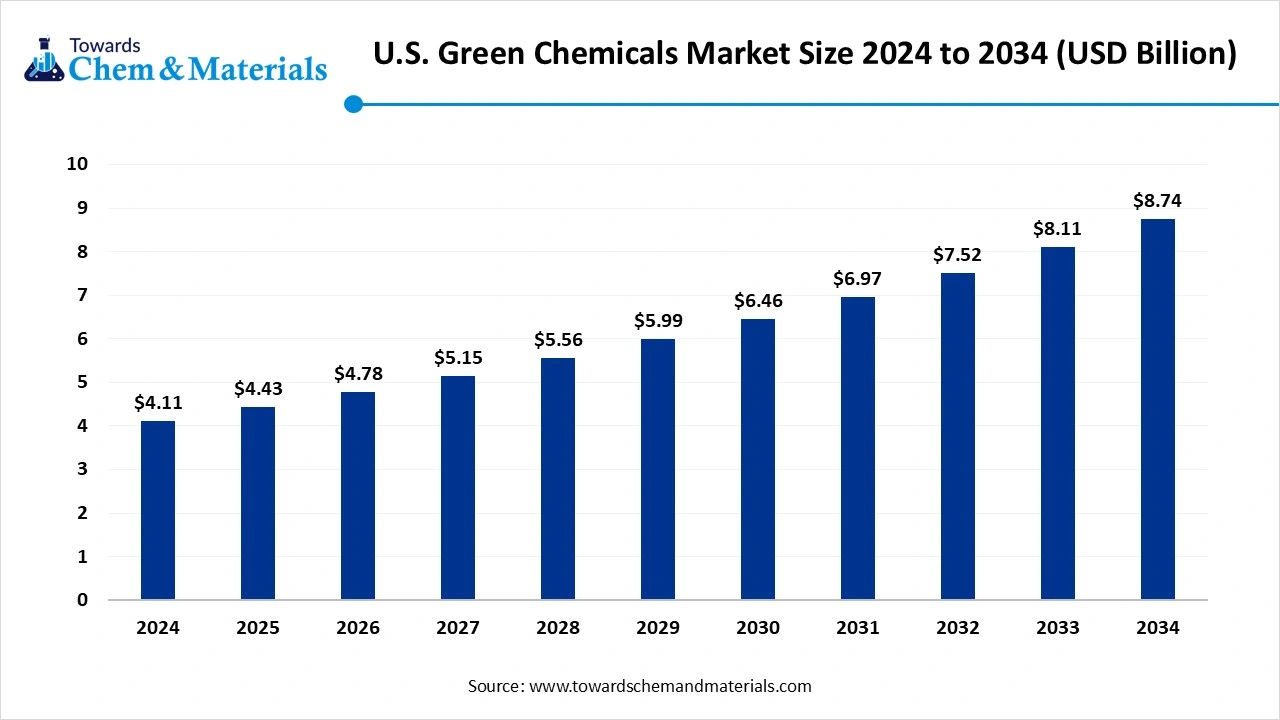November 2025
The U.S. green chemicals market size is calculated at USD 4.11 billion in 2024, grew to USD 4.43 billion in 2025, and is projected to reach around USD 8.74 billion by 2034. The market is expanding at a CAGR of 7.84% between 2025 and 2034.The market demand is driven by increasing consumer demand for sustainable products backe d by strong federal regulatory incentives.

U.S. green chemicals market growth is driven by improvements in bio-based feedstocks and renewable processing technologies, increased consumer demand for sustainable products, and tighter environmental regulations. Two important market segments are bio-alcohols and bio-organic acids. Growth is further fueled by widespread adoption in sectors like packaging, automotive, construction, and specialty chemicals.
Circular Economy and Waste-to-Chemicals Solutions
Emerging trends include converting industrial by-products, agricultural residues, and post-consumer waste into value-added chemicals. This supports circular economy principles by reducing landfill usage, cutting emissions, and creating sustainable feedstock pipelines for chemical production.
Bio-lubricants, bio-solvents, and natural surfactants are examples of specialty chemicals made from renewable resources that are becoming increasingly well-liked. Compared to bulk green chemicals, their uses in personal care, pharmaceutical, and cosmetic products are growing and offer greater value opportunities.
| Report Attributes | Details |
| Market Size in 2025 | USD 4.43 Billion |
| Expected Size by 2034 | USD 8.74 Billion |
| Growth Rate from 2025 to 2034 | CAGR 7.84% |
| Base Year of Estimation | 2024 |
| Forecast Period | 2025 - 2034 |
| Segment Covered | By Product Type / Chemical Class, By Feedstock / Raw Material, By Application / End-Use Industry |
| Key Companies Profiled | Corbion, Evonik Industries (U.S. operations), Genomatica, Inc., Novozymes, Inc., Solvay S.A. (U.S. operations), BioAmber (renewable succinic acid), Amyris, Inc., Green Biologics Ltd.LanzaTech (carbon-to-chemicals technology) |
Waste-to-Chemicals and Circular Economy Solutions
The production of chemicals from waste materials offers a significant opportunity for expansion. Businesses can lower their environmental impact, lower the cost of raw materials, and produce innovative goods from agricultural or industrial waste by incorporating the principles of the circular economy.
Green chemicals often rely on renewable feedstocks or advanced bio-based processes, which are more expensive than conventional petrochemical routes. This makes price competitiveness a major hurdle. Companies must balance sustainability with profitability, often requiring subsidies or incentives to remain viable. High upfront capital investment for green production facilities further limits rapid expansion.
Why Bio-Based Solvents Segment Dominate the U.S. Green Chemicals Market?
The bio-based solvents segment dominated the market with approximately 35% share in 2024, motivated by the growing use of these environmentally friendly substitutes for solvents derived from petroleum in paints, coatings, adhesives, and cleaning products. The dominance of bio-based solvents in a variety of industries was further reinforced by growing consumer demand for safer, nontoxic products and regulatory pressure to reduce volatile organic compounds.
The bio-based polymers & bioplastics fastest growing in the market during the forecast period, owing to rising demand from packaging, consumer goods, and automotive sectors looking to replace conventional plastics with sustainable materials. Government initiatives supporting biodegradable packaging and corporate commitments toward carbon neutrality are accelerating adoption, making this segment a key driver of future market expansion.
How the Plant Oils & Fats Segment Held the Largest Share in the U.S. Green Chemicals Market?
The plant oils & fats segment held the largest revenue share of approximately 40% in the market in 2024, motivated by their broad availability and numerous uses in bio-based lubricants, surfactants, solvents, and bioplastics. Their cost-effectiveness, renewable nature, and ease of integration into current chemical processes make them a popular option for manufacturers
The lignocellulosic biomass segment is experiencing the fastest growth in the market during the forecast period due to its capacity to produce high-value chemicals from forestry waste, non-food crops, and agricultural residues. Due to its scalability and ability to avoid competition with the food supply, this feedstock is becoming more appealing to produce advanced green chemicals and second-generation biofuels.
Which Application Segments Dominated the U.S. Green Chemicals Market?
The packaging & plastics segment dominated the market with approximately 30% share in 2024 due to strong demand for environmentally friendly packaging solutions from consumers and regulations. Corporate sustainability commitments, single-use plastic bags, and growing e-commerce have all contributed to the rapid expansion of bio-based polymers and biodegradable plastics in packaging.
The automotive & transportation segment is the fastest growing in the market during the forecast period, owing to the rising use of bio-based polymers, lubricants, and composites to reduce carbon emissions and improve fuel efficiency. Increasing EV adoption and regulatory pressure on automakers to adopt sustainable materials are accelerating demand for green chemicals in this sector.
The United States stands as one of the largest and most progressive markets for green chemicals in 2025, fueled by the growing demand for environmentally friendly products, stringent regulations, and developments in bio-based technologies. Bioplastics are expanding at the fastest rate, while bio-based solvents dominate the market. Feedstocks are mostly composed of plant oils and fats, while lignocellulosic biomass is rapidly increasing.
| Metric | Value / Details |
| U.S. Exports of organic chemicals in 2024 | USD 51.88 billion |
| Share of U.S. total merchandise exports (2023) represented by organic chemicals (HS commodity group 29) | ≈ 2.56% |
| Top export destinations for U.S. organic chemicals (2023) | Mexico (~USD 6.82 billion), China (~USD 4.20 billion), Belgium, Canada, Italy, Japan, Germany, Netherlands, UK, Brazil |
By Product Type / Chemical Class
By Feedstock / Raw Material
By Application / End-Use Industry
November 2025
November 2025
November 2025
November 2025